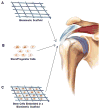Biologics and stem cell-based therapies for rotator cuff repair
- PMID: 30008172
- PMCID: PMC6333521
- DOI: 10.1111/nyas.13918
Biologics and stem cell-based therapies for rotator cuff repair
Abstract
The rotator cuff is composed of several distinct muscles and tendons that function in concert to coordinate shoulder motion. Injuries to these tendons frequently result in permanent dysfunction and persistent pain. Despite considerable advances in operation techniques, surgical repair alone still does not fully restore rotator cuff function. This review focuses on recent research in the use of biologics and stem cell-based therapies to augment repair, highlighting promising avenues for future work and remaining challenges. While a number of animal models are used for rotator cuff studies, the anatomy of the rotator cuff varies dramatically between species. Since the rodent rotator cuff shares the most anatomical features with the human, this review will focus primarily on rodent models to enable consistent interpretation of outcome measures.
Keywords: injury; rotator cuff; stem cells; tendon.
© 2018 New York Academy of Sciences.
Conflict of interest statement
The authors declare no competing interests.
Figures


Similar articles
-
Advances in biologic augmentation for rotator cuff repair.Ann N Y Acad Sci. 2016 Nov;1383(1):97-114. doi: 10.1111/nyas.13267. Epub 2016 Oct 17. Ann N Y Acad Sci. 2016. PMID: 27750374 Free PMC article. Review.
-
Enhancement of tendon-bone healing after rotator cuff injuries using combined therapy with mesenchymal stem cells and platelet rich plasma.Eur Rev Med Pharmacol Sci. 2019 Oct;23(20):9075-9084. doi: 10.26355/eurrev_201910_19310. Eur Rev Med Pharmacol Sci. 2019. PMID: 31696498
-
Regenerative effects of mesenchymal stem cells by dosage in a chronic rotator cuff tendon tear in a rabbit model.Regen Med. 2019 Nov;14(11):1001-1012. doi: 10.2217/rme-2018-0125. Epub 2019 Nov 15. Regen Med. 2019. PMID: 31726959
-
Mesenchymal stem cell-derived exosomes: therapeutic implications for rotator cuff injury.Regen Med. 2021 Aug;16(8):803-815. doi: 10.2217/rme-2020-0183. Epub 2021 Jul 15. Regen Med. 2021. PMID: 34261369 Review.
-
Biologic approaches to enhance rotator cuff healing after injury.J Shoulder Elbow Surg. 2012 Feb;21(2):181-90. doi: 10.1016/j.jse.2011.10.004. J Shoulder Elbow Surg. 2012. PMID: 22244061 Review.
Cited by
-
Clinical perspectives for repairing rotator cuff injuries with multi-tissue regenerative approaches.J Orthop Translat. 2022 Aug 24;36:91-108. doi: 10.1016/j.jot.2022.06.004. eCollection 2022 Sep. J Orthop Translat. 2022. PMID: 36090820 Free PMC article. Review.
-
Rotator cuff healing is regulated by the lymphatic vasculature.J Orthop Translat. 2022 Oct 21;38:65-75. doi: 10.1016/j.jot.2022.09.014. eCollection 2023 Jan. J Orthop Translat. 2022. PMID: 36313978 Free PMC article.
-
Nanofiber Graft Therapy to Prevent Shoulder Stiffness and Adhesions after Rotator Cuff Tendon Repair: A Comprehensive Review.Biomedicines. 2024 Jul 19;12(7):1613. doi: 10.3390/biomedicines12071613. Biomedicines. 2024. PMID: 39062186 Free PMC article. Review.
-
Engineering an enthesis-like graft for rotator cuff repair: An approach to fabricate highly biomimetic scaffold capable of zone-specifically releasing stem cell differentiation inducers.Bioact Mater. 2022 Jan 5;16:451-471. doi: 10.1016/j.bioactmat.2021.12.021. eCollection 2022 Oct. Bioact Mater. 2022. PMID: 35386315 Free PMC article.
-
Innate and adaptive immune system cells implicated in tendon healing and disease.Eur Cell Mater. 2022 Feb 18;43:39-52. doi: 10.22203/eCM.v043a05. Eur Cell Mater. 2022. PMID: 35178698 Free PMC article. Review.
References
-
- Neer CS., 2nd Anterior acromioplasty for the chronic impingement syndrome in the shoulder: a preliminary report. J Bone Joint Surg Am. 1972;54:41–50. - PubMed
-
- Oh LS, Wolf BR, Hall MP, et al. Indications for rotator cuff repair: a systematic review. Clin Orthop Relat Res. 2007;455:52–63. - PubMed
-
- Roh MS, Wang VM, April EW, et al. Anterior and posterior musculotendinous anatomy of the supraspinatus. J Shoulder Elbow Surg. 2000;9:436–440. - PubMed
-
- Galatz LM, Ball CM, Teefey SA, et al. The outcome and repair integrity of completely arthroscopically repaired large and massive rotator cuff tears. J Bone Joint Surg Am. 2004;86-A:219–224. - PubMed
Publication types
MeSH terms
Substances
Grants and funding
LinkOut - more resources
Full Text Sources
Other Literature Sources
Medical

